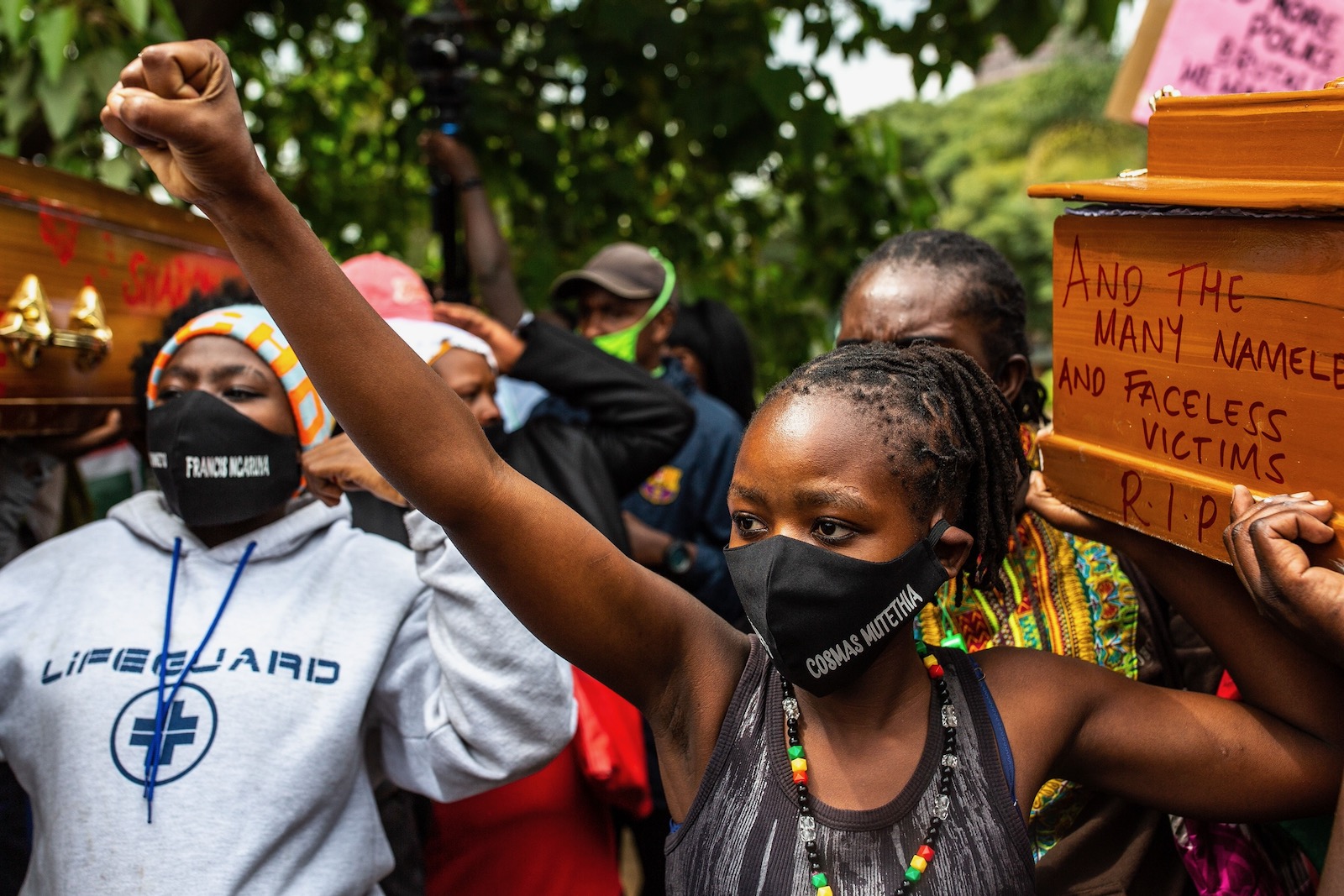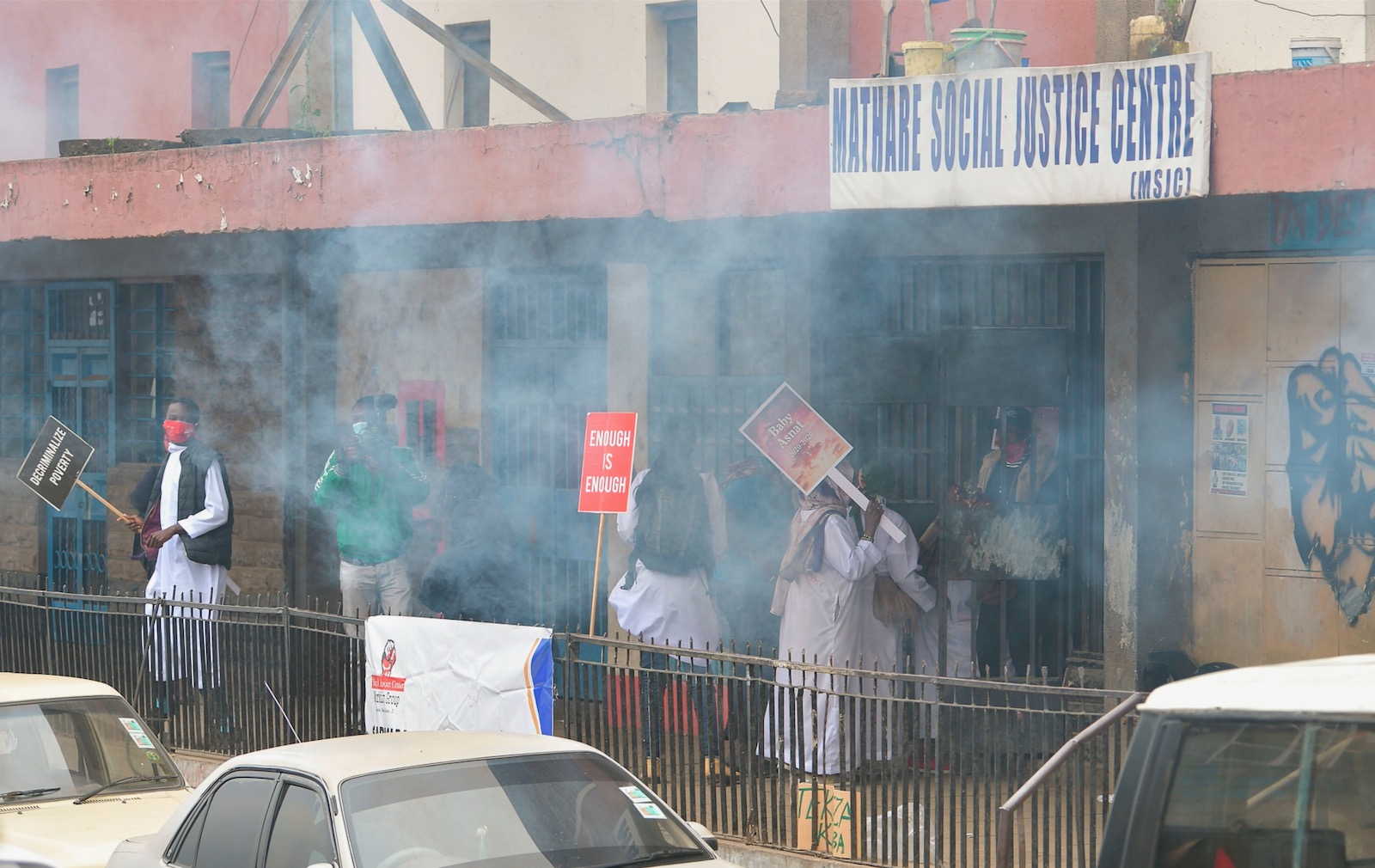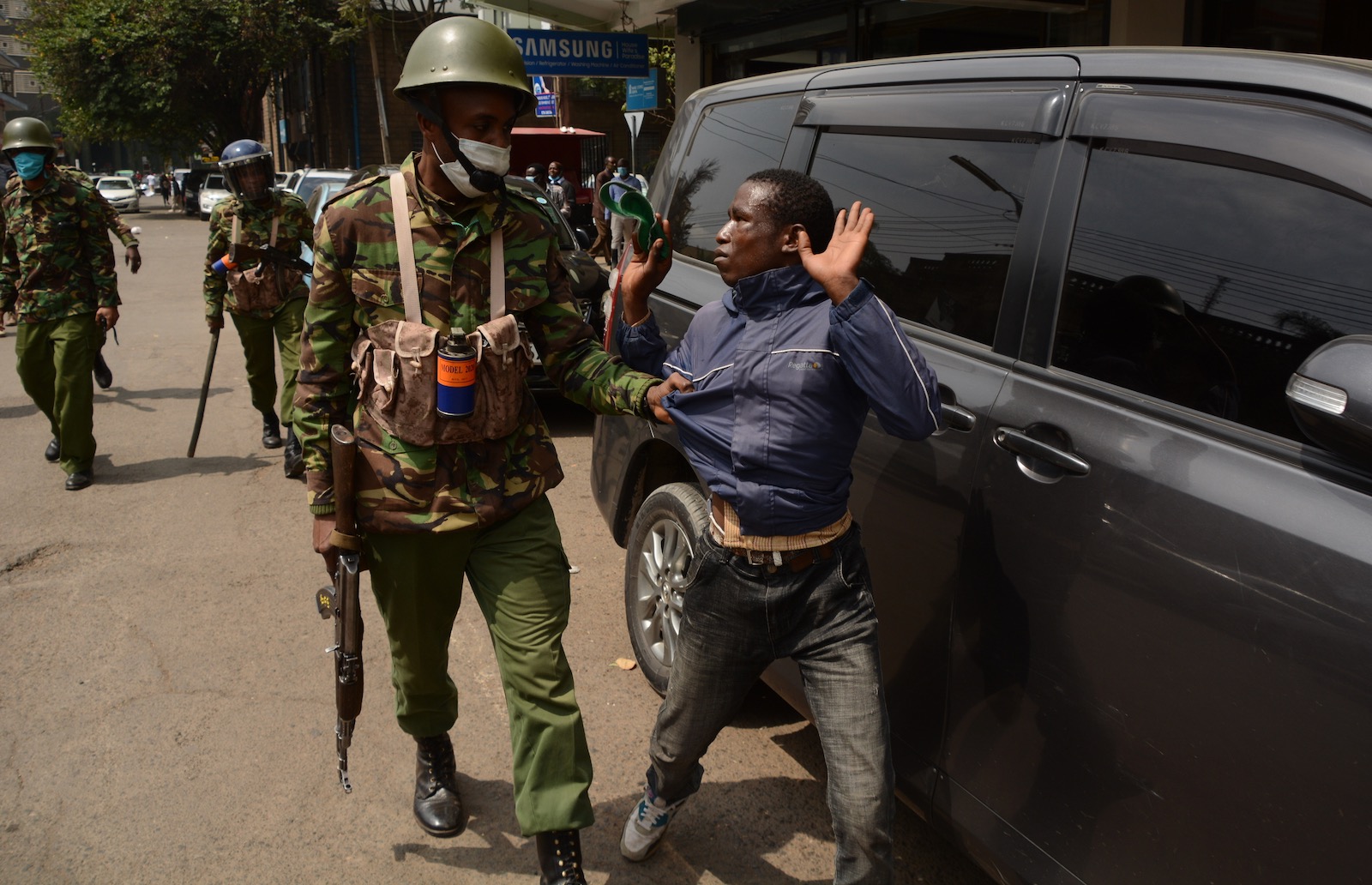Nairobi, Kenya—Not long after Kenya announced its first Covid-19 case on March 13, President Uhuru Kenyatta invoked the Public Order Act to activate a series of measures aimed at curbing the spread of the coronavirus, such as requiring face masks to be worn at all times, vehicles to run at half capacity, and the closure of religious centers, schools, and “non-essential” businesses. But it was the dusk till dawn curfew that became notorious.
The Independent Police Oversight Authority (IPOA), a civilian organization created to monitor police misconduct, says that it has received more than ninety-five complaints of police misconduct and has confirmed thirty deaths, many of which occurred while enforcing this curfew. Missing Voices KE, a consortium of Kenyan human rights organizations, has recorded a higher total of seventeen people who have been killed by police while “enforcing Covid-19 regulations.”
Some of these cases made national headlines, like the murder of thirteen-year-old Yassin Moyo, who was shot by a police officer while standing on the balcony of his family home in Kiamaiko, the eastern part of Mathare, a former quarry that has become one of Nairobi’s largest “slum” districts. (Perhaps because of mounting international attention on police brutality, the IPOA acted with unprecedented alacrity in charging the officer concerned, Duncan Ndiema Ndiwa, with murder; Ndiwa was released on bail earlier this month, after pleading not guilty.) Or the murder of Lazarus Tirop in the Rift Valley town of Ol’Lessos, who was shot by police for not wearing a mask. When demonstrators took to the streets and stormed a police precinct house to protest Tirop’s murder, officers shot and killed two more people.
But other deaths have gone virtually unnoticed. The Mathare Social Justice Centre, a local alliance of community organizers who document cases of police brutality in Mathare, especially extrajudicial executions, has documented the deaths of ten people in Mathare alone, caused, they say, by police violence since the start of the curfew on March 27. The group uses a broader definition of police-involved killings, though: they count, for example, Christine Aoko, who was evading police officers past curfew in Mathare when she fell down the steep, jagged face of the valley. She slipped into the Mathare River, and drowned.
Aoko died because she feared the police more than she did the dangerous terrain she scrambled over at night. Because of the curfew, it wasn’t until the next morning that concerned citizens could wade into the river, trying to recover her body.
*
Stoneface was born and raised in Mathare. His official given name—his “government names,” as he puts it—is Brian Otieno, but on the streets he prefers to go by his artist moniker, which belies his kind eyes and open smile.
When it rains here, brown corrugated-metal roofs fill the air with a buzzing sound like static, and the rainwater flows down to the Mathare and Getathuru Rivers, which roil with the waste of uptown Nairobi from upstream. The dirt in Mathare is black—not fertile-black but dead-black, a composite of plastic waste, dust, and ash from all the fires that define Mathare life: trash-fires, cooking-fires, distilling-fires, house-fires, protest-fires.
The shape of this river valley was sculpted long ago by the flow of the two tributaries. Today, the topography of Mathare is defined by four police stations—one in each cardinal direction, connected by barracks no more than three kilometers apart. For anyone who lives in the informal settlement hemmed inside this fortified valley, these stations are familiar, feared portals from which armed officers emerge and into which young men often disappear. Stoneface traces a hand-drawn map of Mathare, a configuration that, because of his work, he knows all too well. He is one of several human rights defenders with the MSJC.
Here in Mathare, the poor must solve their own murders. Recently, human rights defenders at MSJC have been helping the family of Vitalis Owino secure a paper trail in order to bring Owino’s murderer to justice. The thirty-six-year-old Owino had ventured out on or about the night of May 3–4 to get food and use a public toilet when he was set upon by police officers, who assaulted him for reasons that are still unclear. Owino’s body was found the next morning at the nearby Mradi Area Market, yet, according to MSJC, his death was recorded as the first Covid-19 fatality in Mathare. Though neither Stoneface nor any of his colleagues at MSJC are trained professionals—they are all volunteers, at considerable personal risk—Stoneface is familiar in the techniques of forensic investigation: he pores over postmortems, collects gruesome photos of evidence, tracks down eyewitnesses, and liaises with pathologists. He and his “comrades” do this because no one else will.
Advertisement
In 2017, the group published a report titled “Who Is Next?” that collated evidence from several grassroots human rights organizations across the city to paint a grim and graphic picture of police violence—the systematic extrajudicial killing of people, primarily young men, in Nairobi’s informal settlements. According to the report, most of the victims were going about their ordinary daily business when they were abducted or detained by police. In many cases, the victim was executed with a shot at close range, or in the back, presumably while trying to escape. Sometimes, these shootings took place right in front of family members or neighbors. Among extrajudicial killings that had made it into newspaper blotters from 2013 through 2015, the authors tallied 804 cases: a rate of nearly one every day.
The report made waves because, unlike those of international nongovernmental organizations, it was written by those who lived through the state violence they were documenting. Still, their conclusions were hardly novel. In 2009, the UN Special Rapporteur on extrajudicial, summary, and arbitrary executions, Philip Alston, conducted an investigation in Kenya and reported evidence of widespread police killings that could not be explained away as the work of a few “rogue” officers, but which he attributed rather to institutionalized practices that had evolved in tandem with a rise of organized crime in the city in the 1990s. The transition from autocracy to multi-party democracy simultaneously created a climate in which politicians increasingly mobilized criminal gangs to commit political violence around elections. This conjunction of events led the police force to make extreme, extra-legal measures such as death squads part of their regular operations.
Extrajudicial executions as a tactic, by design, existed outside the justice system but were adopted in the name of efficiency. Although these executions occur outside the law and beyond public scrutiny, the cruel paradox is that the executions themselves are often quite public. Take, for example, the video footage obtained by BBC News Africa showing a plainclothes officer named Ahmed Rashid, who, while keeping his foot on the back of a young man on the ground, appears to call for a pistol and then shoots the man several times. All in broad daylight, surrounded by a crowd. The African Eye reporting underlined what was one of the central problems identified in Alston’s report: impunity.
This kind of policing is not even really about punishment, the meting-out of retributive justice to individuals after they have committed wrongdoing—but rather, punishing the idea of crime itself, in a brutal display of deterrence of future crime that accepts the price of the blood that runs in the streets of settlements like Mathare as necessary, affordable “collateral damage.” Even though the quotidian beatings by police, raids announced with tear gas, and wanton executions are enough to make Mathare seem a conflict zone, this is not a war between equals, nor is it clear what “victory” would look like. It is an endless assault in which any distinction between “means” and “ends” has completely collapsed.
With one circling swoop of his hand above our heads, Stoneface motions at Mathare’s perimeter, its constellation of police stations and barracks. Surrounded. “How can we live?” he asks. “We must back our bags and leave… or we must survive.”
*
Like many other cities with colonial origins, Nairobi was shaped by a railroad and white anxiety. In 1897, the British declared the East Africa Protectorate over Kenya as they embarked on constructing a railway that would connect the port of Mombasa to what is now Uganda. In 1905, because of its central position along the railway, a swampy stretch of land that took its name from the Maasai enkare nyorobi, “place of cool waters,” was declared the protectorate’s capital.
“The colonial world is a compartmentalized world,” Frantz Fanon wrote in The Wretched of the Earth. The work of colonization is the work of separation, and one can trace in Nairobi’s colonial urban design its planners’ awareness that they were outnumbered and surrounded on all sides by those they were exploiting. White settlers laid claim to the higher-altitude sections, with well-draining volcanic red soil, relegating African natives (and, later, sewage works and landfills) to the low-lying, malaria-prone areas with dense, clay-like black soil, widely regarded as the worst kind to build upon. “Asiatics,” as the Indians who had been brought over to work on the railroads were known, were a buffer between. Movement was policed through strict mobility laws that, until 1927, banned Africans from Nairobi altogether unless working there, in which case they were required to wear a box around the neck, called a kipande, containing information about their employer and thus whether they had any business being within city bounds.
Advertisement
Even after Kenya achieved independence in 1963, well-funded attempts to reconfigure the city like the 1973 Nairobi Metropolitan Growth Strategy were ignored. Indeed, far from being dismantled, segregation was “enhanced,” according to University of Nairobi architecture professor Tom Tebesi Anyamba—only now, it was along class lines instead of racial lines. From the 1970s through the 1990s, he writes, “informalization”—the development of urban slums—actually increased, reinforcing the exclusion of the city’s poor majority.
As the city expanded along these de facto apartheid lines, fashioning itself into an outward-looking, international hub, its “anti-city” always followed. To this day, Nairobi always grows in two directions at once: every affluent district has an equal and opposite slum, every new highway inaugurated with an unannounced eviction-by-bulldozer. The colonial work of separation that shaped Nairobi in the early twentieth century continues to shape the city.
Despite being one of Nairobi’s oldest settlements, from its days as a quarry, Mathare does not receive public water because no systematic water grid was ever built. Of the few mains pipes that do exist, many have been blocked as “non-revenue water” by cartels or by the Nairobi City Water and Sewerage Company, a subsidiary of the county government. In certain parts of this so-called metropolis Nairobi, water must still be fetched and purchased by the poor at a price sometimes twenty times greater than the rate for city water, a painful premium. Across the bisecting highway from Mathare is the upscale neighborhood of Muthaiga, dotted with diplomatic residences, home to a historic country club and golf course. There has been piped water there for decades. There, the Constitution “works.”
In Mathare, Stoneface says, it doesn’t. “Ecological injustice” is the term he uses to link together a plethora of seemingly disconnected tragedies: cholera, gang violence, children without schools, tear-gas grenades tossed through windows, poor sanitation, housefires—Stoneface’s list ends with his making the shape of a gun with his hand and… pow! The police bullet may end a life in an instant, but it is the environment, he says, that has already “taken away the sense of humanity inside the people of Mathare.”
But it is precisely because the state has not invested in infrastructure for Mathare that it must police it in the way it does, argues urban ethnographer Wangui Kimari. It is a governance strategy of “neglect and force”; in lieu of basic services, she says, such policing provides the “de facto forms of urban infrastructure” that shape how people move and live.
And nowhere has this been clearer than in the Covid-19 pandemic, during which police have played a starring role in the Kenyan government’s management of the public health crisis. Kenya’s police force can trace a direct lineage back to its colonial-era forerunner, the paramilitary Administration Police that was established in 1958, the final year of the state of emergency during the Mau Mau Rebellion. (Indeed, the Mau Mau’s Nairobi headquarters was in Mathare.) But the police force was only one part of an entire legal apparatus designed to control Kenya’s black population.
The very same Public Order Act that President Uhuru Kenyatta invoked to enable his government’s pandemic measures, is also a colonial relic. Created in 1950, the act criminalized vague infractions like “loitering” and “vagrancy” in order to give police license to “round up pretty much anyone they choose, anywhere they choose,” writes political analyst Nanjala Nyabola. According to Nyabola, these colonial laws, which proved useful tools of repression for Kenya’s authoritarian first two presidents, Jomo Kenyatta and Daniel arap Moi, survived the efforts to bring in constitutional reform and more democratic governance in the 1990s. And now, the Covid-19 crisis has allowed the state to fully rehabilitate the Public Order Act’s original function: policing by terror.
*
Ngũgĩ wa Thiong’o’s 1986 novel Matigari opens with Matigari ma Njirũũngi, a freedom fighter, carefully burying his AK-47 rifle and sword beneath a mũgumo tree, the sacred fig tree that anchors Gĩkũyũ cosmology. After slaying the white land-grabbing colonizer for whom he once worked as a chauffeur, Matigari retires his weapons and emerges from the forest. But the world he enters, a newly “independent” nation, is a dystopia of children queuing to pick through trash for “gains” like discarded radios, police and dogs patrolling the streets, Mercedes Benzes carrying a black ruling class instead of a white one. Disturbed that the people were still not free, Matigari turns back to dig up his weapons and continue the fight for liberation.
Today, his name has become a word that takes on the elided meanings of both “survivor”—not colonizers’ bullets but those of killer cops—and “hero.” Stoneface claims the title for himself—“I am a matigari”—but with the broad definition of anyone who defends the rights of others. It is not a profession but a way of being: resistance as care. Whether they are caring for the loved ones of those killed by police and working to achieve some kind of justice for them, documenting macabre evidence of gunshot wounds and beatings, or demonstrating in the streets to force the state’s atrocities into the sightline of comfortable Kenyans, for grassroots activists like Stoneface and his comrades at MSJC, the medium of their work is pain.
There was an occasion when Stoneface came across some youths celebrating when a local politician donated to the neighborhood a mkokoteni, a wooden rickshaw, plus some jerry-cans, so they could fetch water. Stoneface scolded them: “How dare you, guys? You’re given mkokoteni with jerry cans to go and fetch water. Where is this water?” They could have sat with this politician, he explained, and demanded to know why their faucets run dry in the first place, why some parts of Nairobi “develop” and Mathare is excluded.
For this advice, the young men beat him up, but he didn’t fight back. Just walked away. Sometimes, it is not even the ecological injustice of Mathare that makes him most bitter, he says, but rather when its people are blind to their own oppression, like the children whom Matigari saw delightedly stuffing their mouths with rotten tomatoes from the dump truck.
“The ancestors in Mathare, they are getting angry,” he said, “because the things they were fighting back in the day, we are still fighting even today.” Perhaps the first step in becoming a matigari is knowing that your people are not yet free—even if they themselves don’t know it, yet.





